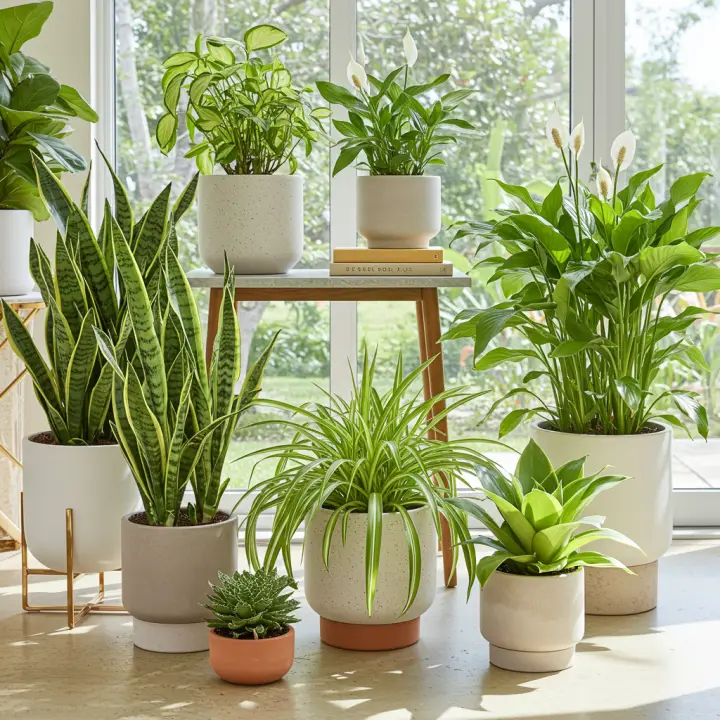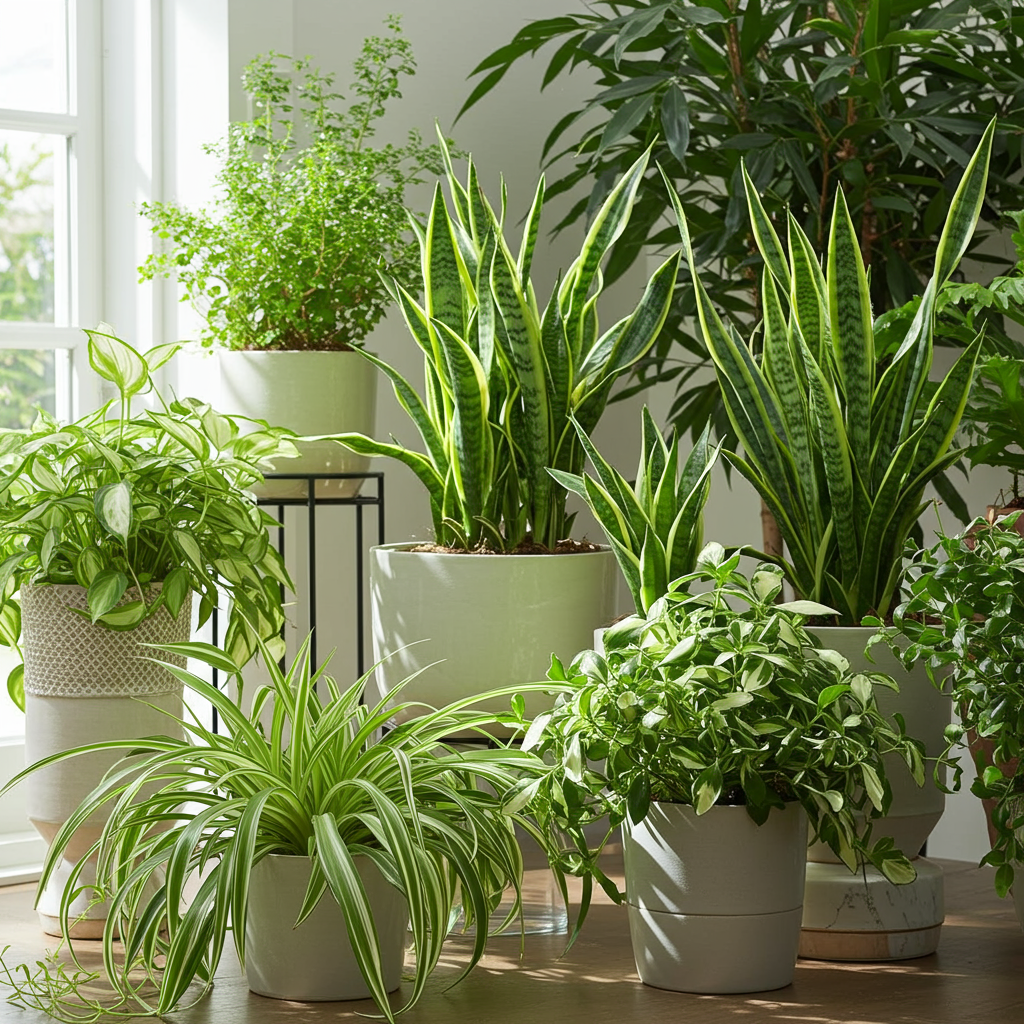Transform your Florida home into a haven of fresh air with the best indoor plants known for their exceptional air-purifying qualities. This guide introduces you to resilient, beautiful plants perfectly suited for the Florida climate, helping you combat indoor toxins and boost your well-being.
Elevate Your Florida Home’s Air Quality with Nature’s Filters

In the sunny state of Florida, where beautiful weather often means keeping windows closed to beat the heat or humidity, indoor air quality can sometimes suffer. Did you know that the air inside your home can be more polluted than the air outside? Common household items, cleaning products, and even furniture can release pollutants like formaldehyde, benzene, and trichloroethylene. The good news? Nature offers a powerful, beautiful, and sustainable solution: air-purifying indoor plants.
These green guardians not only add a touch of lush beauty to your living spaces but actively work to filter out harmful toxins, creating a healthier environment for you and your family. Let’s delve into the world of the best indoor plants that thrive in Florida’s indoor conditions and transform your home into an ultimate clean-air zone.
Why Choose Air-Purifying Indoor Plants for Your Florida Home?
The benefits of incorporating plants into your home extend far beyond aesthetics. For Floridians, who often spend significant time indoors due to weather, these plants are particularly valuable.
The NASA Clean Air Study Connection
Decades ago, NASA conducted a groundbreaking study to find the best ways to purify the air in space stations. Their findings revolutionized our understanding of indoor plants, identifying several common species as highly effective at removing volatile organic compounds (VOCs) from the air. These very same plants can make a remarkable difference in your Florida home.
Beyond Aesthetics: Health Benefits for Floridians
Beyond scrubbing the air of toxins, indoor plants offer a myriad of health advantages:
Stress Reduction: Studies show that interacting with indoor plants can lower stress levels and improve mood.
Improved Focus: A green environment can enhance concentration and productivity.
Boosted Humidity: Many plants release moisture into the air, which can be beneficial in drier indoor environments, especially with heavy AC use.
Reduced Allergens: Some plants can even trap dust particles, though this varies by species.
Enhanced Well-being: Simply being surrounded by nature can foster a sense of calm and happiness.
Top Air-Purifying Indoor Plants Thriving in Florida’s Climate
When selecting plants for your Florida home, it’s wise to choose varieties that can handle the region’s typical indoor conditions, including sometimes lower humidity due to air conditioning, or higher ambient humidity if living coastal. Here are some of the stars of the show:
The Unbeatable Resilience: Snake Plant (Sansevieria trifasciata)
Also known as Mother-in-Law’s Tongue, the Snake Plant is virtually indestructible. It’s a master at converting carbon dioxide into oxygen at night, making it ideal for bedrooms. It effectively filters formaldehyde, benzene, trichloroethylene, and xylene from the air.
Florida Perk: Drought-tolerant and low-light adaptable, perfect for busy Floridians.
Evergreen Goddess: ZZ Plant (Zamioculcas zamiifolia)
The ZZ Plant is known for its waxy, deep green leaves and incredibly tough nature. It can withstand neglect, low light, and inconsistent watering better than almost any other plant. It’s excellent at removing xylene, toluene, and benzene.
Florida Perk: Thrives on neglect, making it a stellar choice for hot Florida summers when you might be traveling.
The Trailing Toxin Buster: Pothos (Epipremnum aureum)
Pothos is a popular choice due to its charming trailing vines and ease of care. It’s highly effective at tackling formaldehyde, benzene, carbon monoxide, and xylene.
Florida Perk: Adapts well to various light conditions and tolerates humidity, perfect for hanging baskets or shelves.
Elegant Bloomer: Peace Lily (Spathiphyllum)
With its striking white “flowers” (modified leaves or spathes) and dark green foliage, the Peace Lily is a beautiful addition to any room. It excels at filtering out formaldehyde, benzene, and trichloroethylene, plus alcohol and acetone.
Florida Perk: Appreciates Florida’s humidity, making it a happy indoor companion.
Natural Humidifier: Boston Fern (Nephrolepis exaltata)
The Boston Fern is not only lovely with its lush, feathery fronds but also acts as a natural humidifier. It’s particularly good at removing formaldehyde and xylene from the air.
Tropical Statement: Areca Palm (Dypsis lutescens)
This elegant palm is a fantastic air purifier, especially for removing formaldehyde, benzene, and carbon monoxide. It also releases a good amount of moisture into the air.
Florida Perk: Brings a touch of the tropics indoors and handles warmer indoor temperatures well.
Colorful Contributor: Chinese Evergreen (Aglaonema)
Chinese Evergreens come in a variety of stunning leaf patterns, from dark green to silver and red. They’re robust and incredibly forgiving, cleaning the air of multiple toxins, including formaldehyde and benzene.
Easy Care Classic: Spider Plant (Chlorophytum comosum)
The classic Spider Plant is a fantastic starter plant and an efficient air purifier, tackling formaldehyde and xylene with ease. Its “spiderettes” make it fun to propagate.
Florida Perk: Adapts happily to a range of indoor conditions, from bright indirect light to slightly shadier spots.
Caring for Your Air-Purifying Heroes in Florida
To ensure your green companions thrive and continue their air-purifying work, a little basic care goes a long way.
Light Requirements: Finding the Perfect Spot
Most air-purifying indoor plants prefer bright, indirect light. Direct sun, especially Florida’s intense afternoon sun, can scorch their leaves. A spot near an east or north-facing window is often ideal. If your home has limited natural light, consider supplementing with a grow light.
Watering Wisely: Don’t Drown Your Darlings
Overwatering is the most common killer of indoor plants. Always check the soil moisture before watering. Stick your finger about an inch or two into the soil; if it feels dry, it’s time to water. Allow excess water to drain completely from the pot. Differing soil types and Florida’s humidity levels can affect how quickly soil dries out.
Humidity & Temperature: Mimicking Their Natural Habitat
Florida’s natural humidity is a blessing for many tropical plants, but air conditioning can dry out indoor air. Most indoor plants are comfortable in temperatures between 65-75°F (18-24°C). If your home is very dry, consider misting your plants occasionally or placing them near a humidifier.
Potting and Fertilizing: Fueling Growth
Use a good quality potting mix that drains well. Repot your plants when they become root-bound, usually every 1-2 years. Feed them with a balanced liquid fertilizer during their growing season (spring and summer), following the product’s instructions.
Where to Find the Best Indoor Plants in Florida
You’ll find a wide selection of air-purifying plants across Florida:
Local Nurseries: Often have knowledgeable staff and a diverse range of healthy plants suited for local conditions.
Home Improvement Stores: Chains like Lowe’s and The Home Depot carry many common varieties.
Online Retailers: Many online plant shops can ship well-packaged plants directly to your door.
Frequently Asked Questions (FAQs)
Are all indoor plants good air purifiers?
While all plants perform some level of carbon dioxide conversion, the term “air-purifying plants” usually refers to species specifically identified by studies like NASA’s for their effectiveness in removing common indoor VOCs. Not all plants are equally potent.
How many plants do I need to purify the air effectively?
The general recommendation, based on the NASA study, is to have 15-18 plants in 6-8 inch diameter pots for an 1,800 square foot home. However, even a few plants can make a noticeable difference in smaller spaces or specific rooms. More plants usually mean better air quality.
Are air-purifying plants safe for pets?
It’s crucial to research each plant’s toxicity if you have pets. Many common air purifiers like Peace Lily and Pothos can be toxic if ingested. Opt for pet-friendly options like Spider Plants, Areca Palms, and Boston Ferns if you have curious furry friends.
Do indoor plants really make a difference to air quality?
Yes! While they aren’t a replacement for proper ventilation, indoor plants significantly reduce levels of common indoor air pollutants. They break down toxins into harmless byproducts that are then stored in their leaves or released as energy.
Can I put my indoor plants outside in Florida?
Many indoor plants are tropical in nature and can thrive outdoors in Florida, especially during warmer months. However, be mindful of direct sun exposure, pests, and ensure you bring them indoors if temperatures drop below their tolerance (typically below 50-60°F for most tropical indoor plants) to protect them from cold damage.
Conclusion: Embrace a Fresher, Greener Florida Lifestyle
Bringing the best indoor plants into your Florida home is one of the simplest yet most effective ways to enhance your environment. These green companions are more than just decorative accents; they are living air filters, stress reducers, and mood boosters. By choosing the right varieties that thrive in Florida’s climate and providing them with basic care, you can create a healthier, more vibrant living space. Start your indoor plant journey today and breathe easier, knowing you’re surrounded by nature’s ultimate air purifiers. Your home, and your lungs, will thank you!

